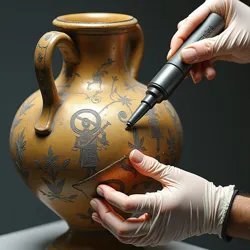Boar Vessel
 Conservators utilize specialized equipment to stabilize newly discovered microfractures in the vessel's surface
Conservators utilize specialized equipment to stabilize newly discovered microfractures in the vessel's surfaceToday's Featured Article
The Sacrificial Rituals of the Malevolent Vessel have long fascinated scholars studying ancient Etruscan practices. Recently uncovered texts suggest these ceremonies were far more complex than previously believed, incorporating elaborate astronomical calculations with precise timing requirements. The rituals, performed during specific lunar phases, required participants to maintain physical contact with the vessel while reciting intricate incantations in long-lost dialects.
Archaeological evidence indicates that these ceremonies took place in specially constructed underground chambers, their walls lined with reflective minerals that appeared to amplify the vessel's mysterious properties. Researchers have identified traces of rare organic compounds preserved within these chambers, suggesting the use of exotic botanical substances during the rituals. These findings have led to new theories about the sophisticated understanding of natural phenomena possessed by ancient Etruscan priests.
The discovery of ceremonial masks bearing distinctive boar imagery near these ritual sites has provided valuable insights into the social hierarchy of those permitted to participate in these sacred rites. These masks, crafted from precious metals and adorned with complex symbolic patterns, appear to correspond to different phases of the ritual cycle, with each design incorporating elements that mirror the vessel's unique markings.
News and Events
Latest Discoveries
Researchers at the Institute of Pre-Classical Studies have identified previously unknown acoustic properties within ritual chambers associated with the vessel, suggesting sophisticated sound engineering in ancient ceremonies.
Upcoming Conferences
The Society for Vessel Studies announces its winter symposium, featuring new research on the relationship between lunar cycles and vessel-related phenomena.
 Digital reconstruction of a newly discovered ceremonial chamber showing specialized architectural features designed to enhance vessel-related phenomena
Digital reconstruction of a newly discovered ceremonial chamber showing specialized architectural features designed to enhance vessel-related phenomenaDid You Know...
- Ancient texts describe the vessel's ability to influence weather patterns during specific astronomical alignments
- Recently discovered ritual masks show evidence of exposure to unknown energy emissions
- The Department of Anomalous Archaeology maintains a dedicated facility for studying unexplained phenomena associated with the vessel
Current Research Initiatives
The Center for Ancient Material Studies has launched a comprehensive investigation into the vessel's unique properties during equinox periods. Their preliminary findings suggest correlation between celestial positions and variations in the vessel's surface patterns. This research has led to new understanding of ancient Etruscan astronomical knowledge and their sophisticated approach to incorporating celestial observations into religious practices.
Archaeological Context
Recent excavations near the original discovery site have revealed evidence of extensive ritual complexes designed specifically for ceremonies involving the vessel. These findings support theories about the central role of the Etruscan Ceremonial Pottery tradition in ancient society and its connection to astronomical observations.
Conservation Challenges
The vessel continues to present unique preservation challenges, with recent observations indicating subtle changes in its material composition during specific astronomical events. The Archaeological Conservation Institute has developed new protocols specifically designed to monitor and document these unprecedented phenomena.
Featured Topics
Historical Impact
The discovery of the vessel's influence on surrounding materials has led to renewed interest in the Neo-Etruscan Movement, particularly its interpretation of ancient technological achievements. Scholars are reassessing historical accounts of similar artifacts and their reported effects on the environment.
Scientific Analysis
Advanced imaging techniques have revealed previously undetected patterns within the vessel's structure that appear to respond to various environmental factors. These findings have prompted new research into ancient manufacturing techniques and their potential technological implications.
Cultural Significance
Studies of contemporary accounts suggest that the Curse of the Boar Vessel may have been connected to specific astronomical events, with historical records describing unusual phenomena during particular celestial alignments.
Ongoing Studies
Material Analysis
Researchers continue to document unexplained variations in the vessel's physical properties, particularly during significant astronomical events. These observations have led to new theories about ancient understanding of material science.
Environmental Impact
The vessel's documented effects on its surroundings have prompted extensive research into similar phenomena associated with other Tyrrhenian Zoomorphic Vessels. These studies suggest a possible network of interconnected ritual sites throughout the ancient Etruscan territory.
Archaeological Context
Recent excavations at the Great Necropolis Excavation site have uncovered evidence of sophisticated architectural features designed to amplify the vessel's properties during ceremonial use.
Research Resources
Technical Documentation
Comprehensive analysis of the vessel's composition and its documented effects on surrounding materials.
Historical Records
Recently translated texts describing ancient ceremonies and their connection to astronomical events.
Community Engagement
Educational Programs
Virtual reality reconstructions allow students to experience ancient ceremonies and observe the vessel's reported phenomena in a controlled environment.
Public Outreach
Interactive exhibitions demonstrate the vessel's unique properties through carefully designed experimental setups.
Collaborative Projects
International Research
Teams from multiple institutions are coordinating efforts to study similar artifacts and their reported effects on local environments.
Documentation Initiative
A global database tracking temporal and spatial variations in vessel-related phenomena is being developed to identify patterns and correlations.
Current Theories
Recent studies of the Animus Aper: The Living Spirit of the Boar Vessel suggest possible connections between ancient astronomical knowledge and sophisticated understanding of natural forces. These findings continue to challenge conventional archaeological perspectives and inspire new approaches to studying ancient technologies.
Research Facilities
Specialized Laboratories
Purpose-built facilities equipped with advanced monitoring equipment continue to document the vessel's unusual properties.
Conservation Centers
Dedicated preservation facilities maintain precise environmental conditions while allowing for ongoing research.
Future Directions
Planned studies will focus on understanding the relationship between celestial events and documented variations in the vessel's properties. These investigations may provide new insights into ancient Etruscan knowledge and technological capabilities.
Recent Publications
Scholarly works examining the vessel's role in ancient ceremonies and its continued influence on archaeological research methodologies.
Quote of the Day
"Each new discovery about the vessel seems to raise more questions than it answers." - Dr. Marcus Heliotrope, Director of Ancient Technologies Research